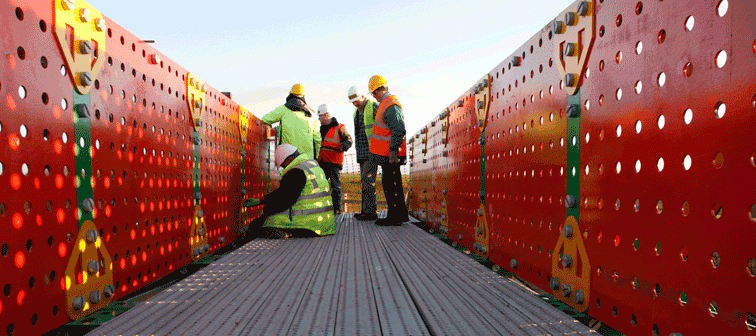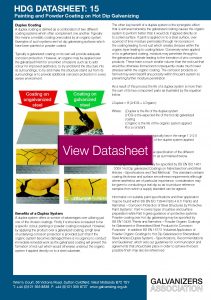What Type Of Paint To Use For Galvanized Metal Pipe
Tin you paint over galvanised steel?
Hot Dip Galvanizing by itself is a long lasting, cost effective ways of corrosion protection. However, galvanised steel can be painted for the post-obit reasons:
- add colour for aesthetic, camouflage, or safety purposes
- increment the economic life of a structure
- provide additional protection in very aggressive environments
All paint systems used should be specifically formulated for utilise on galvanized steel and applied in accordance with the pigment manufacturer'due south recommendations.
How to paint galvanized metallic
Painting galvanised metal is very piece of cake every bit long as the right steps are carried out. The post-obit is a quick introduction for the process:
- Preparation of galvanized steel earlier painting. There are iv recognised methods of surface pre-handling that produce a sound substrate for a paint blanket: t wash, etch primers, sweep diggings and weathering.
- Selecting the correct pigment for galvanised metallic. All paint systems should be specifically formulated for use on galvanized steel and applied in accordance with the paint manufacturer'due south recommendations.
- Application of the paint coating should be carried out in accordance to the manufacturer'due south instructions, i.e. time of application, dry film thickness and curing rates.
Footstep one tin be skipped for direct application of paint over galvanised metals. A limited number of directly application products available which negate the need for chemic or mechanical pre-treatment to exist conducted. These products are known to have been used in a variety of applications.
Do yous need to prime galvanized metal earlier painting?
Applying a primer can be part of the pre-treatment of galvanised steel (read more below about How exercise you prepare galvanized steel earlier painting). However, it is not admittedly necessary, as mentioned before, in that location are a limited number of straight application products available which negate the demand for chemic or mechanical pre-treatment.
How to prepare galvanized steel for painting
Guidelines for the pre-handling for painting of galvanized metals take been drawn up as a result of (i) a written report carried out by an independent research centre and a leading UK pigment manufacturer into the functioning of commercially available pre-treatment and pigment systems and the parameters affecting their performance on hot dip galvanized coatings, and (2) many years experience with duplex coatings.

Although pre-treatment of galvanized components is all-time carried out immediately afterward galvanizing, before the surface has become contaminated in any style, this is not always practical. Pre-handling can exist carried out later just it is vital that the surface is adequately cleaned to remove all traces of contaminants such every bit oil, grease and dirt. The cleaning operation must get out no residues on the cleaned surface and any moisture storage staining should be removed using a stiff castor. Washing downwardly the coating with water volition aid to remove soluble salts.
There are four recognised methods of surface pre-treatment that produce a audio substrate for a pigment coating:
1. T-Wash (or its proprietary equivalent)
Despite the fact that this grooming process has been available for some considerable time, T-Wash is still generally considered to be the best pre-treatment method for painting galvanized steel.
T-Wash is a modified zinc phosphate solution which contains a minor amount of copper salts. When applied, a night grey or black discolouration of the zinc surface volition result.
T-Wash must not be allowed to pool on horizontal surfaces or this will prevent maximum paint adhesion. Whatsoever backlog should exist removed past water.
How long tin I leave the T-wash on galvanised steel for?
T-launder is most suitable for application to new galvanizing and should not be used on weathered galvanizing (see etch primers beneath). Sufficient time must exist immune for the T-Wash to react and dry thoroughly before the first coat of paint is applied. (Suppliers' data will requite recommended fourth dimension intervals).
While research has shown that T-Washed surfaces tin can be left for upwards to 30 days before painting and good paint adhesion can still upshot, information technology is advisable to minimise the time betwixt pre-treatment and pigment awarding. Whatsoever white common salt formed by the exposure of the T-Washed surface to wet must be removed before painting, using a strong brush. If the T-Washed surface has become contaminated it must be cleaned in accordance with the suppliers' recommendations.
Constituents of T-Wash
The constituents of T-Launder are phosphoric acid (9.0%), ethyl cellusolve (16.5%), methylated spirit (16.5%), water (57.0%) and copper carbonate (one.0%). Variations to this composition may be and then it is wise to consult the supplier if a successful issue is to be accomplished.
2. Etch primers
Etch primers have also been used successfully. Their major disadvantage is the absenteeism of whatsoever visible colour change as is the case with T-Wash. Therefore, there can never exist complete confidence that all surfaces take reacted with the primer. Etch primers are most suited to awarding on older, weathered galvanizing.
three. Sweep diggings
A mechanical method of pre-handling is sweep blasting using fine copper slag, J blast or carborundum powder with a blast pressure of no greater than 40psi (ii.7 bar). This will ensure that only the minimum amount of oxide is removed and the zinc surface is left in a slightly roughened status. Intendance should be taken when carrying out sweep diggings on very thick galvanized coatings to avoid impairment to the coating. The optimum nozzle-to-work piece distance and angle of blasting needs to be identified for all surfaces on the galvanized steelwork if optimum results are to be accomplished. Angular atomic number 26 blasting grit must non be used nether whatever circumstances. Sweep blasting is oft used in add-on to the chemical training phase.
4. Weathering
This process merely becomes fully constructive after a galvanized surface has been exposed to the temper for a flow of at least vi months. The surface is prepared using either annoying pads or a stiff brush to remove all loose adherent materials and making sure that the bright zinc surface is not restored.
This is followed by a hot detergent wash and rinsing with fresh clean water. The surface must be fully dry before any paint is practical. Weathering should non be used equally a method of surface preparation in marine environments with high chloride levels.
How to choose a paint for galvanised metal
All paint systems used should be specifically formulated for use on galvanized steel and applied in accord with the paint manufacturer's recommendations.
What kind of paint do you use on galvanized steel?

Duplex Coatings
The choices of paint systems on galvanised metallic will depend upon both the awarding and service environment. With the decline in the use of chlorinated prophylactic and alkyd paints, loftier-build epoxy products and vinyl/vinyl co-polymer systems are increasingly utilised with glass reinforced epoxy being an option for more severe environments. In multi-glaze systems the use of micaceous iron oxide (MIO) primer has been shown to give improved adhesion.
Ii-pack polyurethane and acrylic urethanes are commonly used as superlative coats and offer good durability and colour retentivity. Alternatives include acrylic epoxies and polysiloxanes, the latter offering increased abrasion resistance forth with good gloss and colour retention.
At nowadays, loftier-build epoxies are widely used although water-based products, including polyurethanes, are now existence specified. They are less tolerant of poor pre-handling but their use could proceed to grow as the Solvent Emissions Directive becomes more stringent.
Painting galvanised steel – examples
Ditton Colina Firm by Surman Weston
"If the owners decide in xx years that they want a business firm that is not completely white, they can strip off the paint and accept a squeamish finish."
Percy Weston, Surman Weston
Ditton Colina House is a two bedchamber dwelling in an archetypal suburban town, that has an exposed exoskeleton. Watch the video below to find out more.
9 Elms Thames Path Pavilion by Studio Weave
Working in collaboration with Churchman Mural Architects, the aim of the projection was to heighten the Thames Riverside Walk in Ix Elms whilst large-scale building piece of work is carried out locally. A series of new planters along the Thames Path were the first stage, and a primer projection for the pavilion.
The planters are constructed from the aforementioned proprietary metallic panels as the pavilion would later be, unremarkably used to construct water tanks. They accept been sprayed with a copper finish, which will acquire a natural green Verdigris over time as they weather and change. Read more near Ix Elms Thames Path Pavilion
Painted galvanized steel case studies
Click to check out more examples of painting on galvanized steel.
Pattern for galvanizing
Learn more nearly design for stiffeners, welded gussets, webs on columns and beams, and gussets and how to let the free menses of molten zinc across the surface, enhancing drainage from the structures. Read hither about pattern detailing.
Source: https://www.galvanizing.org.uk/painting-galvanized-steel/
Posted by: sancheznotheity.blogspot.com


0 Response to "What Type Of Paint To Use For Galvanized Metal Pipe"
Post a Comment